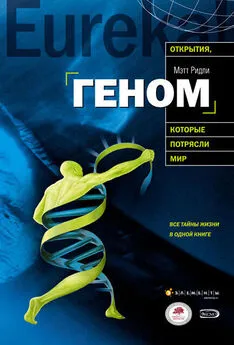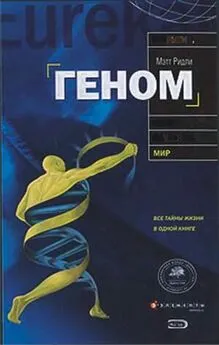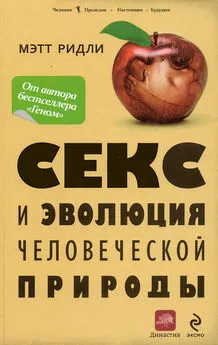Мэтт Ридли - Геном: автобиография вида в 23 главах
- Название:Геном: автобиография вида в 23 главах
- Автор:
- Жанр:
- Издательство:Эксмо
- Год:2008
- Город:Москва
- ISBN:978-5-699-30682-4
- Рейтинг:
- Избранное:Добавить в избранное
-
Отзывы:
-
Ваша оценка:
Мэтт Ридли - Геном: автобиография вида в 23 главах краткое содержание
Генетика развивается столь стремительно, что уследить за тем, как изменяются наши представления о фундаментальных основах жизни и наследственности, не успевает не только широкая публика, но и специалисты. Это порождает массу слухов и домыслов о страшных мутантах, которых коварные ученые штампуют в своих лабораториях, тогда как поразительные открытия новых методов диагностики и лечения генетических заболеваний, включая рак, остаются незамеченными или непонятыми. Книга Мэтта Ридли очень актуальна. Просто и доступно автор представил историю генетики от первых догадок до ошеломляющего прорыва, начавшегося с открытия структуры ДНК Уотсоном и Криком.
На английском языке книга вышла в свет в конце 1999 года, в канун нового тысячелетия. Но эта книга по-прежнему занимает топовые позиции в рейтингах продаж по всему миру. В ней есть то, что не устаревает: дух научных открытий и история генетики, представленная со всем драматизмом споров, дискуссий, озарений одних ученых и черной завистью других.
Геном: автобиография вида в 23 главах - читать онлайн бесплатно ознакомительный отрывок
Интервал:
Закладка:
Примечания
1
Erasmus Darwin. 1794. Zoonomania: or the laws of organic life . Vol. II, p. 244. Third ed. 1801. J. Johnson, London.
2
Campbell J. 1983. Grammatical man: information, entropy, language and life . Allen Lane, London.
3
Schrödinger E. 1967. What is life? Mind and matter . Cambridge University Press, Cambridge.
4
Judson H. E. 1979. The eight day of creation . Jonathan Cape, London.
5
Hodges A. 1997. Turing . Phoenix, London.
6
Campbell J. 1983. Grammatical man: information, entropy, language and life . Allen Lane, London.
7
Gesteland R. F., Atkins J. F. (eds). 1993. The RNA world . Cold Spring Harbor Laboratory Press, Cold Spring Harbor, New York.
8
Gold T. 1992. The deep, hot biosphere. Proceedings of the National Academy of Science of the USA 89: 6045–6049;
Gold T. 1997. An unexplored habitat for life in the universe? American Scientist 85: 408–411.
9
Woese C. 1998. The universal ancestor. Proceedings of the National Academy of Science of the USA 95: 6854–6859.
10
Poole A. M., Jeffares D. C., Penny D. 1998. The path from the RNA world. Journal of Molecular Evolution 46: 1–17;
Jeffares D. C., Poole A M., Penny D. 1998. Relics from the RNA world. Journal of Molecular Evolution 46: 18–36.
11
Kottler M. J. 1974. From 48 to 46: cytological technique, preconception, and the counting of human chromosomes. Bulletin of the History of Medicine . 48: 465–502.
12
Yang J. Z. 1950. The life of vertebrates . Oxford University Press, Oxford.
13
Arnason U., Gullberg A., Janke A. 1998. Molecular timing of primate divergences as estimated by two non-primate calibration points. Journal of Molecular Evolution 47: 718–727.
14
Huxley T. H. 1863/1901. Man’s place in nature and other anthropological essays . p. 153. Macmillan, London.
15
Rogers A., Jorde R. B. 1995. Genetic evidence and modern human origins. Human Biology 67: 1–36.
16
Boaz N. T. 1997. Eco homo . Basic Books, New York.
17
Walker A., Shipman P. 1996. The wisdom of bones . Phoenix, London.
18
Ridley M. 1996. The origins of virtue . Viking, London.
19
Bearn A. G., Miller E. D. 1979. Archibald Garrod and the development of the concept of inborn errors of metabolism. Bulletin of the History of Medicine 53: 315–328;
Childs B. 1970. Sir Archibald Garrod’s conception of chemical individuality: a modern appreciation. New England Journal of Medicine 282: 71–77;
Garrod A. 1909. Inborn errors of metabolism . Oxford University Press, Oxford.
20
Mendel G. 1865. Versuche über Pflanzen-Hybriden. Verbandlungen des naturforschenden Vereines in Brünn 4: 3–47.
21
Цит. по кн.: Fisher R. A. 1930. The genetic theory of natural selection . Oxford University Press, Oxford.
22
Bateson W. 1909. Mendel’s principles of heredity . Cambridge University Press, Cambridge.
23
Цитата Мишера приводится в книге Bodmer W., McKie R. 1994. The book of man . Little, Brown, London.
24
Hayes B. 1998. The invention of the genetic code. American Scientist 86: 6–14.
25
Scazzocchio C. 1997. Alkaptonuria: from humans to moulds and back. Trends in Genetics 13: 125–127;
Fernandez-Canon J. M., Penalva M. A. 1995. Homogentisate dioxygenase gene cloned in Aspergillus. Proceedings of the Natural Academy of Sciences of the USA 92: 9132–9136.
26
Gusella J. F. et al. 1996. Hantington’s disease. Cold Spring Harbor Symposia on Quantitative Biology 61: 615–626.
27
Huntington G. 1872. On chorea. Medical and Surgical Reporter 26: 317–321.
28
Wexler N. 1992. Clairvoyance and caution: repercussions from the Human Genome Project. In: Kevles D., Hood L. (eds), The code of codes , p. 211–243. Harvard University Press.
29
Hantington’s Disease Collaborative Research Group. 1993. A novel gene containing a trinucleotide repeat that is expanded and unstable on Hantington’s disease chromosomes. Cell 72: 971–983.
30
Goldberg Y. P. et al. 1996. Cleavage of huntingtin by apopain, a proapoptotic cysteine protease, is modulated by the polyglutamine tract. Nature Genetics 13: 442–449;
DiFiglia M. et al. 1997. Aggregation of huntingtin in neuronal intranuclear inclusions and dystrophic neurites in brain. Science 277: 1990–1993.
31
Kakiuza A. 1998. Protein precipitation: a common etiology in neurodegenerative disorders. Trends in genetics 14: 398–402.
32
Bat O., Kimmel M., Axelrod D. E. 1997. Computer simulation of expansions of DNA triplet repeats in the fragile-X syndrome and Hantington’s disease. Journal of Theoretical Biology 188: 53–67.
33
Schweitzer J. K., Livingston D. M. 1997. Destabilisation of CAG trinucleotide repeat tracts by mismatching repair mutations in yeast. Human Molecular Genetics 6: 349–355.
34
Mangiarini L. 1997. Instability of highly expanded CAG repeats in mice transgenic for the Hantington’s disease mutation. Nature Genetics 15: 197–200.
35
Clong S. S. et al. 1997. Contribution of DNA sequence and CAG size to mutation frequencies of intermediate alleles for Huntington’s disease: evidence from single sperm analysis. Human Molecular Genetics 6: 2820–2825.
36
Wexler N. S. 1992. Mapping fate . University of California Press, Los Angeles.
37
Wexler N. 1992. Clairvoyance and caution: repercussions from the Human Genome Project. In: Kevles D., Hood L. (eds), The code of codes , p. 211–243. Harvard University Press.
38
Wexler N. S. 1992. Mapping fate . University of California Press, Los Angeles.
39
Hamilton G. 1998. Let them eat dirt. New Scientist , 18 July 1998: 26–31;
Rook G. A. W., Stanford J. L. 1998. Give us this day our daily germs. Immunology Today 19: 113–116.
40
Cookson W. 1994. The gene hunters: adventures in the genome jungle . Aurum Press, London.
41
Marsh D. G. 1994. Linkage analysis of IL4 and other chromosome 5q31.1 markers and total serum immunoglobulin E concentrations. Science 264: 1152–1156.
42
Martinez F. D. 1997. Association between genetic polymorphism of the beta-2-adrenoceptor and response to albuterol in children with or without a history of wheezing. Journal of Clinical Investigation 100: 3184–3188.
43
Chorney M. J. et al., 1998. A quantitative trait locus associated with cognitive ability in children. Psychological Science 9: 1–8.
44
Galton F. 1883. Inquiries into human faculty . Macmillan, London.
45
Goddard H. H. 1920. — цит. по кн.: Gould S. J. 1981. The mismeasure of man . Norton, New York.
46
Neisser U. et al. 1996. Intelligence: knowns and unknowns. American Psychologist 51: 77–101.
47
Philpott M. 1996. Genetic determinism. In: Tam H. (ed.), Punishment, excuses and moral development . Averbury, Aldershot.
48
Wright L. 1997. Twins: genes, environment and the mystery of identity . Weidenfeld and Nicolson, London.
49
Scarr S. 1992. Developmental theories for the 1990s: development and individual differences. Child Development 63: 1–19.
50
Daniels M. et al. 1997. Of genes and IQ. In: Devlin B. et al. (eds), Intelligence, genes and success . Copernicus, New York.
51
Herrnstein R. J., Murray C. 1994. The bell curve . The Free Press, New York.
52
Haier R. et al. 1992. Intelligence and changes in regional cerebral glucose metabolic rate following learning. Intelligence 16: 415–426.
53
Gould S. J. 1981. The mismeasure of man . Norton, New York.
54
Furlow F. B. et al. 1997. Fluctuating asymmetry and psychometric intelligence. Proceeding of the Royal Society of London, Series B 264: 823–829.
55
Neisser U. 1997. Rising scores on intelligence tests. American Scientist 85: 440–447.
56
Freeman D. 1983. Margaret Mead and Samoa: the making and unmaking of an anthropological myth . Harvard University Press, Cambridge, MA.
57
Harlow H. F. et al. 1971. From thought to therapy: lessons from primate laboratory. American Scientist 59: 538–549.
58
Pinker S. 1994. The language instinct: the new science of language and mind . Penguin, London.
59
Dale P. S. et al. 1998. Genetic influence on language delay in two-year-old children. Nature Neuroscience 1: 324–328.
60
Paulesu E., Mehler J. 1998. Neuroscience: Right on in sign language. Nature 392: 233–234.
61
Carter R. 1998. Mapping the mind . Weidenfeld and Nicolson, London.
62
Bishop D. V. M. et al. 1995. Genetic basis of specific language impairment: evidence from twin study. Developmental Medicine and Child Neurology 37: 56–71.
63
Fisher S. E. et al. 1998. Localisation of a gene implicated in a severe speech and language disorder. Nature Genetics 18: 168–170.
64
Gopnik M. 1990. Feature-blind grammar and dysphasia. Nature 344: 715.
65
Fletcher P. 1990. Speech and language deficits. Nature 346: 226.
66
Gopnik M. et al. 1996. Genetic language impairment: unruly grammars. In: Runciman W. G., Maynard Smith J., Dunbar R. I. M. (eds), Evolution of social behaviour patterns in primates and man , p. 223–249. Oxford University Press, Oxford;
Gopnik M. (ed.) 1997. The inheritance and innateness of grammars . Oxford University Press, Oxford.
Читать дальшеИнтервал:
Закладка:



![Twelve Angel - Супер Ген Бога. Том 13 [1201-1300 главы]](/books/1077409/twelve-angel-super-gen-boga-tom-13-1201.webp)
![Twelve Angel - Супер Ген Бога. Том 12 [1101-1200 главы]](/books/1077410/twelve-angel-super-gen-boga-tom-12-1101.webp)
![Twelve Angel - Супер Ген Бога. Том 11 [1001-1100 главы]](/books/1077411/twelve-angel-super-gen-boga-tom-11-1001.webp)
![Twelve Angel - Супер Ген Бога. Том 10 [901-1000 главы]](/books/1077412/twelve-angel-super-gen-boga-tom-10-901.webp)
![Twelve Angel - Супер Ген Бога. Том 9 [801-900 главы]](/books/1077413/twelve-angel-super-gen-boga-tom-9-801-900-glavy.webp)
![Twelve Winged Dark Burning Angel - Супер Ген Бога. Том 2 [101-200 главы]](/books/1080401/twelve-winged-dark-burning-angel-super-gen-boga-tom-2-101-200-glavy.webp)

